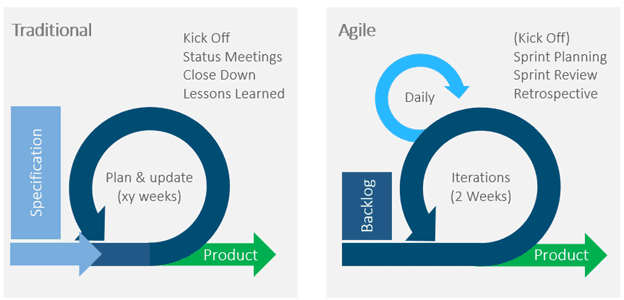How to use a “Hybrid” Project Management approach
What is “Hybrid” project management?
Simply put, hybrid project management is a blend of two or more common project management methodologies, such as Waterfall and Agile.
Have you noticed over the past several years that the term “hybrid” project management has gained a lot of traction? You see it in job descriptions, recruiters use it to vet out candidates for job placements, and especially you see it being used in the consulting industry by companies wanting to use “buzz” words to highlight their project management skills and prowess.
With that said, is hybrid project management real? Yes, it is. Ok, so now that we know a hybrid approach is a real and vetted-out approach to project management is this “hybrid” method something you and your project team should adapt to and use on your projects?
The answer (in most cases) is yes! In today’s highly complex and technical projects that include more than just infrastructure and software development as well as cloud-based infrastructure, enterprise-wide solutions, and organizational change management, a hybrid environment is really the only way to help ensure success for your projects.

So, when is a Hybrid approach appropriate?
First and foremost, you must approach utilizing a hybrid model carefully and ask yourself (as the project manager) one very important question:
Is the project team and client willing and able to adapt to new a project management method?
If the Answer is yes, proceed with adapting a hybrid approach that best fits you, your team, the client, and the solution you are delivering.
If your project team or client is not willing to adapt to a new method, then the answer is a resounding NO – a hybrid approach is not for you and your team. Even though a hybrid solution would work and be beneficial for your project, the project team, and your clients buy-in is crucial to being successful with a new project management method.
Congratulations, you, your team, and your client has accepted the idea of a hybrid project management approach. What now?
Now that you have buy-in, you, your team, and the client are excited about how a hybrid solution and approach will benefit them. The next question is how will it benefit the project, what do you do now, and how do you get started?
Good question! At this point in the process, you might be thinking “What have I done?” or “What have I gotten myself, my team, and the client into?” I don’t know what the H.E. double L I am doing because I have never done this before.
Luckily, it is not a hard as it may seem. There are decisions to make and planning to do to position you and your team to be successful with a hybrid approach.
Decisions? What decisions? Planning? What Planning?
First, you need to take a step back and look at the overall project, your team, and of course your client and decide what is broken and what isn’t.
- A good place to start with this is a lesson’s learned exercise using your last project. By leading your team through lesson’s learned review, you can quickly gauge where things are going well and where things need attention.

After you have found what is working and not working, you can apply this information to how you are going to plan out your hybrid approach.
Second, carefully decide and choose “your” hybrid elements and approach.
- The blend of waterfall and agile elements you implement will change depending on the type of project you are undertaking. You need to consider what parts of the project are flexible (Agile) and what parts of the project are clearly defined and fixed with little to no room for flexibility (Waterfall).
- Use Waterfall for the items that have little or no room for flexibility.
- Use Agile for the items that have room for flexibility.

Example of when to use a hybrid project management approach:
The Project:
A new enterprise-wide solution that includes a new cloud-based infrastructure and data migration utilizing your software vendor’s Customizable Off The Self-solution (COTS).
Even with this high-level project description, you can make a few of decisions on what waterfall and agile elements you can start incorporating into your project plan.
- Waterfall elements:
- Cloud-based infrastructure
- Installation of vendor software
- Information gathering/gap sessions with vendor
- Data migration
- Agile elements:
- Vendor COTS software solution
Utilizing an agile approach when the project starts, the software customization phase allows you, your project team, and the client to quickly adapt to changes. How the solution is configured giving (the client the ability to see the solution) and working software in iterations (Sprints) allows the client to truly customize the solution to meet their needs and requirements.
More than likely, you are not going to get the perfect blend of a hybrid approach and method the first time around. Don’t worry! Continue to modify your elements and approach until you find the hybrid sweet spot for you, your team, the client, and the project.

Training, Training, Training
Training cannot be emphasized enough! You will not be successful if you do not take the time to train your team and client on both what Agile is and how you are going to implement and manage the hybrid solution. I suggest starting with a basic Agile Training class which gives your team and client the background on what Agile is, what the events are and when and why they are used as well as how to conduct an overall agile project. To know where you are headed, you must first know where you are or where you are coming from.
Thanks, that’s great, but how do I manage all of this?
There are several programs, tools, and software solutions available and at your disposal for managing all types of projects, such as Microsoft Project and Jira. It is not recommended to try and manage a project with two different solutions – you should always manage your projects utilizing one solution only. Attempting to manage a project with multiple programs will cause missed tasks and project delays. This is not “if it will happen” it is a “when it will happen” – because it will.
Agile features were introduced with the latest release of Microsoft Project allowing you to seamlessly manage your hybrid project using both waterfall and agile elements. This gives you (as the project manager) better overall control of the project and its hybrid elements.


Now you’re going places!
With team and client buy-in as well as planning and training, you and your team can be successful with hybrid project management and bring a new and exciting approach to your projects. If you have any questions or concerns around hybrid philosophies, check out our training classes below to help you rise to the level of Hybrid Project Manager!
Arrowhead Consulting Services Training Classes


